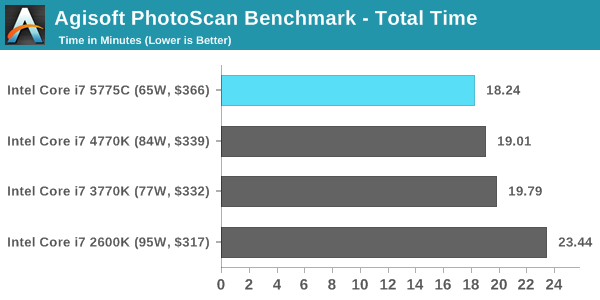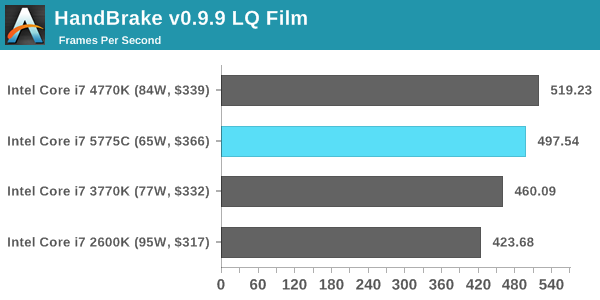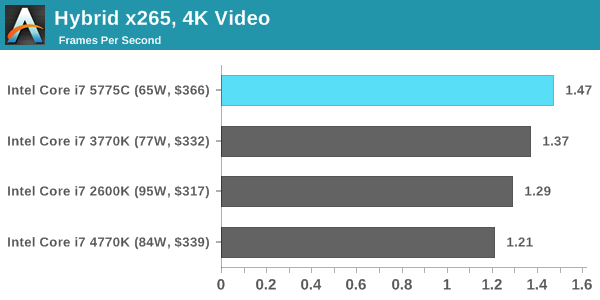The Intel Broadwell Review Part 2: Overclocking, IPC and Generational Analysis
by Ian Cutress on August 3, 2015 8:00 AM ESTProfessional Performance: Windows
Agisoft Photoscan – 2D to 3D Image Manipulation: link
Agisoft Photoscan creates 3D models from 2D images, a process which is very computationally expensive. The algorithm is split into four distinct phases, and different phases of the model reconstruction require either fast memory, fast IPC, more cores, or even OpenCL compute devices to hand. Agisoft supplied us with a special version of the software to script the process, where we take 50 images of a stately home and convert it into a medium quality model. This benchmark typically takes around 15-20 minutes on a high end PC on the CPU alone, with GPUs reducing the time.

Cinebench R15
Cinebench is a benchmark based around Cinema 4D, and is fairly well known among enthusiasts for stressing the CPU for a provided workload. Results are given as a score, where higher is better.


HandBrake v0.9.9: link
For HandBrake, we take two videos (a 2h20 640x266 DVD rip and a 10min double UHD 3840x4320 animation short) and convert them to x264 format in an MP4 container. Results are given in terms of the frames per second processed, and HandBrake uses as many threads as possible.


Hybrid x265
Hybrid is a new benchmark, where we take a 4K 1500 frame video and convert it into an x265 format without audio. Results are given in frames per second.











121 Comments
View All Comments
Shadowmaster625 - Monday, August 3, 2015 - link
I never understood the "pea size" method. Peas come in many different sizes. And it seems to me that the size of a typical pea is rather large. You need something standard, like a bb. They are a standard size, 0.177 caliber, and three of them in a line seems to work best.Pissedoffyouth - Monday, August 3, 2015 - link
I put a grain of rice size in the middle. get a glasses cloth and rub it on both the heatsink and the heat spreader, and rub it off. Should be a slight tinting left.Then put another grain of rice size in the middle and screw the heatsink in. Done.
You want to use the bare minimum amount of paste.
zodiacfml - Monday, August 3, 2015 - link
Very polarizing CPU. Any ideas why Intel doesn't have Crystalwell in laptops? I don't want a discrete GPU anymore in mobile due to risk of dead GPUs/Mobo after a few years.zodiacfml - Monday, August 3, 2015 - link
Oh, nevermind! I found them.extide - Monday, August 3, 2015 - link
They do, but the CPU's with Crystalwell are quite expensive, so most OEM's shy away from them because it is too expensive for a cheap laptop, and then a higher end laptop they put a dGPU in.In my next laptop, I want a Iris Pro (w/ Crystalwell) chip, and NO DGPU! I don't want the power consumption, and Iris Pro is plenty enough performance for what I do on a laptop. Unfortunately, it's kinda hard to find high-ish end laptop's with that config. :(
Gigaplex - Monday, August 3, 2015 - link
Before Broadwell, the only way to get Crystalwell was in the mobile chips.varg14 - Monday, August 3, 2015 - link
Until my pretty much 5 year old Sandy Bridge 2600k that runs between 4.5-5.0ghz PCIE 2.0 @ 8x lane speed does not bottleneck a dual GPU setup to the point it can not push at least 60FPS at 3440-1440 resolution on my 34" 21/9 LG 34UM95 monitor their is no reason to upgrade whatsoever.Also with DX12's reduced CPU overhead any new DX12 games should run great with a old Sandy CPU. Also DX12 Should greatly improve the performance of my EVGA's GTX 770 4gb Classified SLI setup since it will split frame render instead of alternate frame rendering allowing the vram to be sorta stacked since each card is only rendering half a frame instead of a whole frame allowing the 4gb of Vram on each card to act like one 8GB card.
PrinceGaz - Monday, August 3, 2015 - link
Skylake should be the big one that has been waited for since Sandy Bridge; Ivy Bridge's tick reduced overclockability because of the process node, Haswell improved IPC but added the onboard voltage regulator which made overclocking at that node still worse, and Broadwell keeps the voltage regulator whilst further focussing on lower power.I'm not saying Skylake will go to the dizzying raw gigahertz of Sandy Bridge, but two generations of tocks, and the removal of the onboard voltage regulator, and if we're lucky, the improved thermal compound used in Haswell Devil's Canyon, could together make for a significantly faster chip; one which may well see the upper ends of the 4.x GHz attainable.
Impulses - Monday, August 3, 2015 - link
Fingers crossed, if it can come near SB levels of OC I'd be complacent... Just enough for the IPC advantage not to be mitigated by raw clock speed, I'm really upgrading my 2500K for the platform anyway (M.2 in particular) but it'd be nice to get a halfway decent CPU upgrade.Aspiring Techie - Monday, August 3, 2015 - link
The Broadwell equivalent of a Sandy Bridge 5.0 GHz overclock in raw instruction throughput (assuming that Skylake doesn't have any improvement in ipc) is 4.3 GHz. A 4.6 GHz Haswell overclock is equivalent to a 4.4 GHz Broadwell. Broadwell wasn't designed for the desktop, so it isn't designed for good overclocking. If Skylake's consumer flagship has the same clocks as the 4790K with say 10% ipc over Broadwell, then at 4.4 GHz, it has will have the same instruction throughput as a 5.0 GHz Haswell or a 5.7 GHz Sandy Bridge chip. The overclock should increase as the 14nm process becomes more mature, so less voltage is needed for better clocks. If Intel does it right, then everyone will be happy (except AMD since Zen would be screwed over).